Water Rescue Kit – The Ultimate FAQ Guide
A swift and immediate rescue effort is required whenever somebody falls into a fast-moving body of water.
It is critical for everyone going on a trip down the beach or other swift-moving stream to be adequately outfitted so that they can react nearly instantly.
Having the appropriate equipment on hand improves the odds of a successful rescue.
We have explained below the necessary information about the water rescue kit and why you need them. Read to save yourself from emergency water situations.
1. What Is a Water Rescue Kit?
Emergencies can strike at any time and in any place. It may happen at home, on the road, or in the wild. An emergency can evict you from your home and leave you stranded miles from civilization.
When you add in inclement weather, it’s easy to see how this could be a difficult period. Having a well-prepared emergency bag with a high-quality flashlight will be invaluable when the time comes.
Because you can’t predict the time and location of an emergency, it’s essential to be prepared in multiple areas. Have an emergency kit at your home and in all of your cars, trucks, RVs, and other vehicles.
Similarly, a water rescue kit can save you from water-related miseries. The water rescue kit can save you if you fall into the water while boating.
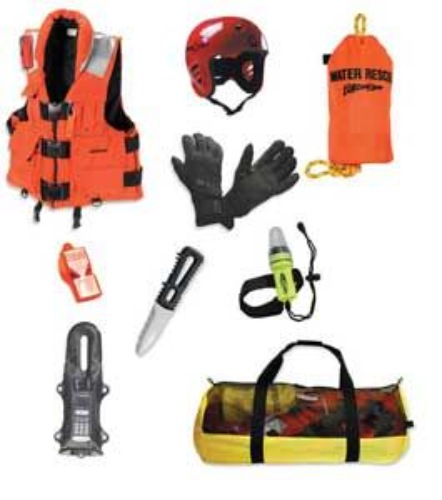
Figure 1 Water Rescue Kit
2. What Does a Water Rescue Kit Contain, and What Is the Purpose of this Equipment?
A water rescue kit consists of versatile tools to assist in water-related emergencies. Below is a detailed account of the tools and the purpose they serve.
· Throw Line
In fast-moving or motionless water, a throwline bag is the safest approach to reach a subject. When rescuers must go into the water, it provides a downstream safety backup.
Throwline bags should be kept in patrol cars, ambulances, and other emergency response vehicles.
It is a piece of safety equipment that you should have on hand if near or on water. A non-distressed individual should use these gadgets to assist someone in the water and unable to return to land or their boat. They are only to be used in an emergency and should not be used regularly.
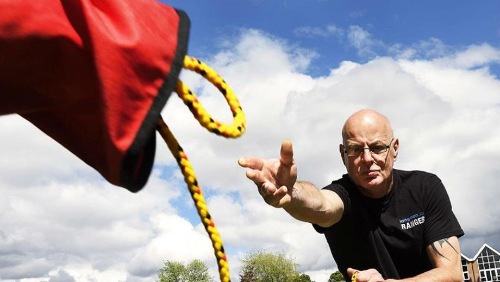
Figure 2 Throw Line
· Loud Hailer
It is a microphone and amplifier fitted inside a portable loudspeaker. It is used to call the drowning or missing people so that they can hear and come for help.
· 170N Life Jacket
It’s comfortable, wearing a size that’s not too bulky, and it gives you a lot of buoyancy when you’re in the water.
The bladder is designed to float the user above the water at a specific angle and height. Most sailors will find the 170N suitable for overnight sailing, offshore weekend racing, coastal passages, and cruising.
· 300N Life Jacket
When wearing a substantial protective waterproof jacket, 300N (automatically inflating) is suited for all waterways and all situations, including extreme weather.
In the event of unconsciousness, the vest will still keep you safe by turning you while keeping your airways free of the water. Reflective striping and visual inspection windows are included.
When conducting a heavy manual activity, this life jacket is meant to be simple, comfortable, and non-restrictive to wear.
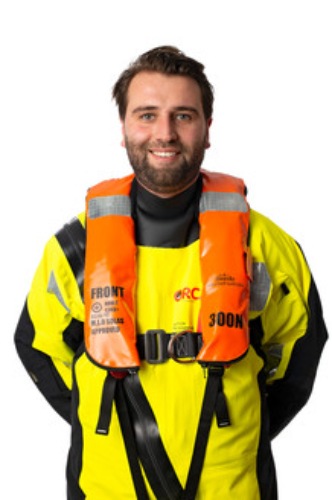
Figure 3 300N Life Jacket
· Rescue 850 PFD
The most important thing is to be safe. For safety and rescue workers, the Rescue 850 is the industry standard.
It’s been put to the test in some of the world’s most challenging rescue situations. The safest rescue PFD is available, with single-handed release buckles, a 50 mm rapid release harness, lash tabs, and high visibility reflective panels.
· Lanyard
The Individual Rescue Lanyard is designed for various uses, including water rescue and extraction.
· Torch
The most apparent function of a flashlight in an emergency bag is to light your surroundings, whether indoors or out.
Although not all emergencies happen at night, several elements such as geography and easily navigated obstructions during the day become exceedingly deadly at night if you can’t see them.
Having a high-quality flashlight on hand will considerably reduce the risk.
· River Knife
River knives are designed for rafting, kayaking, and other freshwater activities. It’s intended for situations where you’re imprisoned underwater by rope or straps and need to cut yourself free.
They’re stainless steel, tiny, and light, making them easy to carry and use, though not all of them have sharp points like the one you saw.
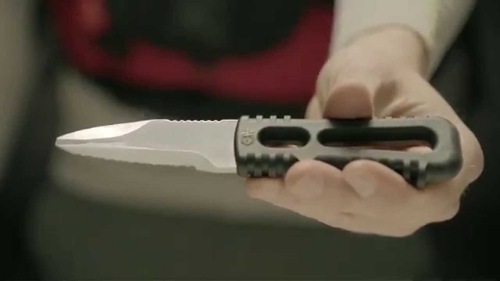
Figure 4 River Knife
· Helmet
Professional rescuers require equipment that allows them to respond safely and quickly. The helmet is designed to be light and comfortable to wear. It conforms to the requirements of the water helmet standard.
· Drysuit
Drysuits are full-body suits designed to keep you completely dry while you’re out enjoying your favorite activities.
These suits are often made of synthetic rubber or neoprene with a robust external shell.
Water is kept out by flexible rubber seals around the user’s neck and wrists, and the main suit zipper (also waterproof) allows the wearer to put on the suit quickly.
· Drysuit Bag
When your drysuit is not in use, it is stored in a drysuit bag. The bag has a water-resistant lining that helps to keep moisture contained within the pack.
Because of its large size, the bag can also be used as a changing pad while open.
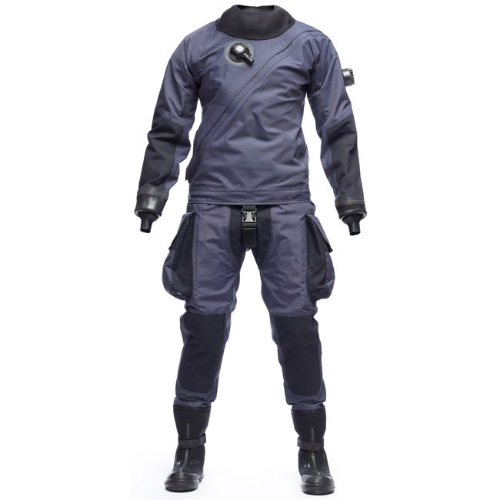
Figure 5 Drysuit
· Valise
A tiny piece of baggage that may be carried by hand is used to store clothing and other items such as a suitcase or travel bag.
3. In What Conditions a Water Rescue Kit Is Used?
Every professional or tour leader should have a few supplies on hand to ensure that anyone who goes overboard has a higher chance of making it back to the boat.
Even if you enjoy sailing, you need to ensure that you have the proper equipment to get you through a complex scenario.
It’s also worth noting that not all rescues are for those who have fallen into the water.
A swift body of water can sometimes push a craft into a tight area, confining the people or causing the vessel to overturn.
The rescue team should focus rescue equipment on rescuing those who fall out of a craft and become stuck and gathering everyone from a capsized vessel.
It’s not just about being able to float when you fall into the water or become caught in it for an extended amount of time; it’s also about remaining warm in chilly water. The truth is that excellent life jackets hug the body closely, keeping your body temperature where it needs to be until aid arrives.
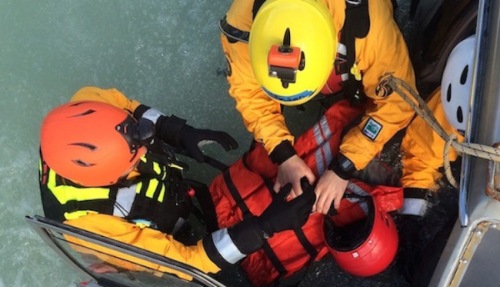
Figure 6 Water Rescue Equipment
If you are abruptly flung from a boat or a jet ski, you may suffer serious injuries.
Most life jackets are designed to flip you over, so you face the sky rather than the ocean. That slight alteration could mean the difference between life and death.
You must wear a life jacket whenever you are on the water, whether for a relaxing boat ride or a thrilling jet ski experience.
Some people, however, are not convinced that life jackets are beneficial. If you’re still not convinced, consider why life jackets are so necessary.
4. Who Uses a Water Rescue Kit?
Everyone who goes out on the water should use a water rescue kit.
In bodies of water with fast-moving currents, however, a more durable water rescue kit is required to assist someone who has fallen into the water.
Water rescue kits are constructed of bright colors and are meant to provide additional comfort and durability. The thicker material protects the wearer’s critical organs, while the bright colors make it easier to spot the person against the water’s neutral and darker colors.
The water safety vests are also more buoyant, allowing the wearer to maintain their head above water in fast-moving water.
The throw bag can be attached to the water rescue vest and used to pull the person out of the river.
Other possibly necessary items, such as a light, knives, or other small gear, can be stored in the vest’s front pockets.
A whistle is usually attached, offering the sufferer a chance to alert rescuers if they are stuck or stranded with their head above water.
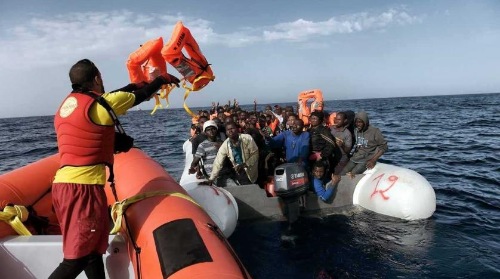
Figure 7 Rescurer Using Water Rescue Kit
5. How Do You Rescue a Drowning Person Using a Water Rescue Kit?
Water rescuers aren’t the only ones to think about what to do in a water-related emergency.
You never know when you’ll need to think quickly and devise a strategy to pull a troubled individual from a pool, lake, or ocean.
Wear a life-saving jacket whenever possible is the first rule of water safety. These are material coats that keep you afloat.
They may not be the most attractive apparel, but they can save your life if you aren’t a good swimmer.
How to Help the Drowning?
However, if someone is in the water without a life jacket or needs assistance, remember to reach down to him and help.
This act captures one of the most critical aspects of a water rescue, particularly for those of us who aren’t water lifeguards.
Don’t put yourself at risk while attempting to rescue a panicked person from the water. You can wind up being driven underwater yourself, leaving two victims needing assistance rather than one.
Rescue Using a Water Kit
You can employ several tools to save people’s lives. Depending on the situation and the rescue stage, several types of gear must be used.
The following is a list of some of the most prevalent lifeguarding devices.
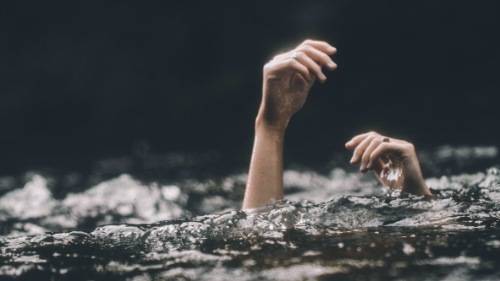
Figure 8 Saving a Drowning Person
Throw Bag
A toss or throw bag is a necessity for every boat. The essential items in a throw or rope bag are the ropes you need to save someone who has fallen out of the vessel, similar to the rescue floats used in the ocean.
The drowning person can slide the harness from either side, allowing rescuers to focus on getting the water rescue kit to the sufferer and the victim to secure himself more rapidly with the equipment.
Once the collar is on, the rescuer can pull the rope taut, and the device will cinch around the victim’s chest, securing the victim. This gear makes pulling someone out of the water more manageable, even during a helicopter lift.
Lines for Hauling
The haul line aids in moving trapped or stuck vessels back into the stream.
It has a rope that works as a static line to help pull the boat away from the rocks.
Smaller vessels, such as kayaks, can use thinner lines, and some businesses employ throw bags.
For larger vessels, however, it is preferable to have something substantial built to carry the weight of the larger craft while being hauled.
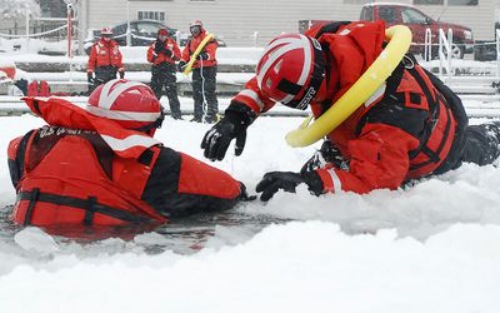
Figure 9 Helping a Drowning Person
Webbing
It is an item that is frequently overlooked, yet it is critical for certain types of rescues. Some streams or rivers are narrow enough that no additional anchors are required, but they can have different widths and debris that a vessel can utilize to anchor a line.
Using webbing, you can add more length and stability to your water rescue kit. Webbing usually comes with its stainless-steel D-ring and carabiner, so you don’t have to worry about having these items on hand in other situations.
The webbing tether is attached to the shoulder strap and does not get in the way.
Gloves
Rapidly moving water is frequently frigid, and the cold wetness will make gripping the rope to pull someone to safety more difficult.
Rescuers can use special water rescue gloves to hold the ropes better and bring someone to safety.
Oxygen Cylinder
Emergency oxygen cylinders provide additional oxygen to individuals with difficulty breathing.
A pulse oximeter determines the person’s pulse and oxygen levels.
The rescuer then turns on the oxygen cylinder and fills the airbag with sufficient oxygen, depending on the sufferer’s needs.
Then he instructs the victim to breathe gently and steadily. Because oxygen cylinders are under high pressure, lifeguards must handle them with extreme caution.
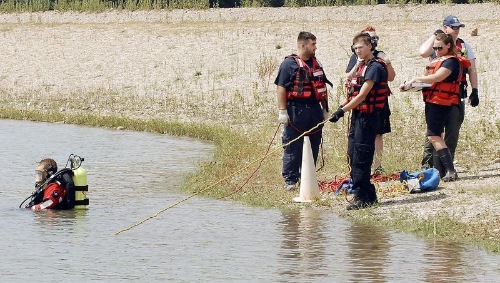
Figure 10 Oxygen Cylinders
Lifejackets
Lifejackets are a well-known safety item that is particularly useful in life-saving measures. They’re made of polyester fabric and loaded with foam to keep you afloat in the water.
They also come with a whistle and an emergency light, so the person in need of assistance may readily draw attention to themself.
Rescue Tube
A rescue tube is a high-density foam tube that you can use in various ways to keep a person from drowning.
The lifeguard swims out, carrying the rescue tube behind him until he reaches the distressed victim. The victim can then take a break on the rescue tube and begin swimming toward the shore with the lifeguard’s assistance.
If the person is too weary or traumatized to swim, the tube can be wrapped around their body and dragged back to the shore by a lifeguard.
6. Does the Water Rescue Kit Work in the Fire?
Suppose you are enjoying yourself at a beach or a river. And you suddenly catch fire on your boat or at the hut nearby. The water rescuing kit can aid you in this matter.
You can wear life jackets to jump in the water and use other tools in the equipment as per your requirement. So, you can efficiently utilize a water rescuing kit in fire because something is always better than nothing.
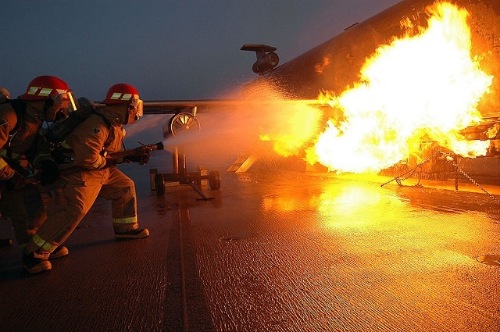
Figure 11 Water Rescue Kit in Fire
7. Does the Water Rescue Kit Contain Jackets for Kids?
Yes, there is a lot of variety in the water rescuing kit. You can get small to medium sizes according to your kid’s size. Some companies also offer customization services to build you the size you need for your kid.
Life jackets can help keep you safe. The one you purchase must be appropriate for your body type.
If your life jacket is too big and falls off, you’re not doing yourself any favors.
On the other hand, if your jacket is too small, it may not be able to keep you afloat. Locate a jacket that fits before you get in the water.
Also, if you’re an adult, make sure you’re wearing an adult jacket, and if you’re a child, make sure you’re wearing a child’s jacket.
According to their parents, a child’s life jacket should fit snugly and be free of wear and tear.
Have someone stand behind you and try to pull your lifejacket over your head as a test to see if it fits appropriately and is synced up properly.
It’s either too big, or the adjustable straps need tightening if the lifejacket rides up over your head.
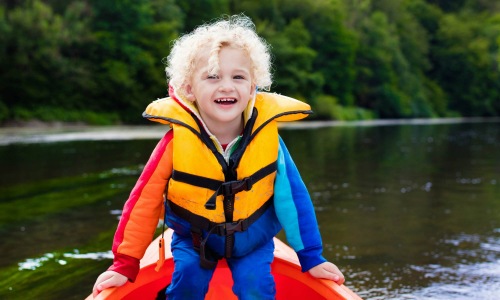
Figure 12 Kids Life Jackets
8. Are Water Rescue Kits Available in Various Types?
Yes, a water rescue kit is available in various types. Depending upon the location and water depth, there are different water rescue kits to deal with the dangers of different intensities.
For example, if you need water rescue kits for a place where kids come and play, the kits for the rescue team must contain life jackets for kids. Similarly, for areas with women, the kit is equipped with life jackets for women.
However, life saving equipment is present in all the kits, which ever you choose for your vessel.
9. What Are the Benefits of a Water Rescue Kit?
The benefits of having a water rescuing kit are as follows.
A Sense of Calmness
Having a water rescuing kit gives you peace of mind because you can’t foresee when you’ll be in a water-related accident.
For peace of mind and comfort, knowing you have a backup plan in case of an accident or boat trouble is essential.
Boating with peace of mind can help you stay calm. You must have all of the necessary items on hand to assist you in dealing with any potential injuries.
If you want to drive the boat with peace of mind, make sure you carry the best water rescuing kit with you.
Immediate Help
Another benefit of carrying a roadside water rescuing kit in your boat is that it can provide quick aid. It enables you to deal with any injuries and problems effectively and fast.
Unfortunately, you will not always be able to access a hospital. Waiting for emergency medical help could put people’s lives in jeopardy. A beachside emergency pack can help you deal with the situation and get help quickly.
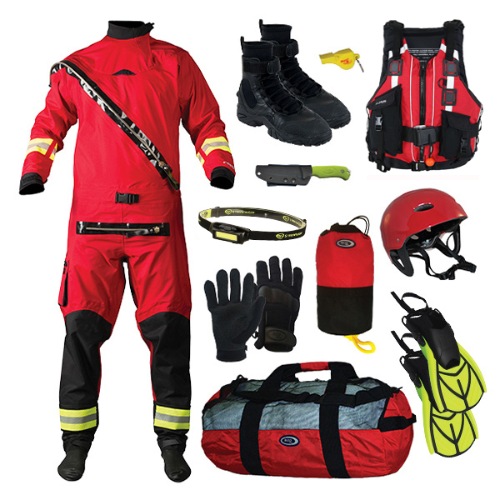
Figure 13 Rescue Kit in Emergencies
Helps in Communication
Emergencies can cut you off from the rest of the world, mainly if they occur in a distant location.
You may find yourself in a position where your phone lines and cell towers are down. It may be challenging to contact close ones or ask for assistance.
It becomes feasible to contact the outside world when you have a water rescuing kit with communication equipment such as solar radios and portable chargers.
It’s also critical to get local updates and information when you’re in an emergency. You must be aware of what is going on around you to make informed decisions.
To obtain local news in your location, make sure you have an AM/FM frequency radio.
Easily Recognizable
Water rescue kits that are easily identifiable and conspicuous are beneficial. Uniformity among lifeguards reduces confusion and may even save lives.
When authorities fail to demand matching uniforms and instead allow lifeguards to choose what they want to wear, visibility and recognition of lifeguards become nearly tricky, especially when many people are present.
Hundreds of people can be in the water at once in extensive facilities. It means that lifeguard teams must be able to spot their teammates in and out of the water rapidly.
Uniforms for lifeguards bring the agencies together and promote respect for the guards.
Lifeguard uniforms were predominantly red or navy with white marking in the past. Today, some organizations cling to conventional hues, while others choose uniform colors that reflect their park’s concept or logo.
When patrons could not find a guard when they required one, beaches and water parks that did not have matching lifeguard uniforms were sued.
